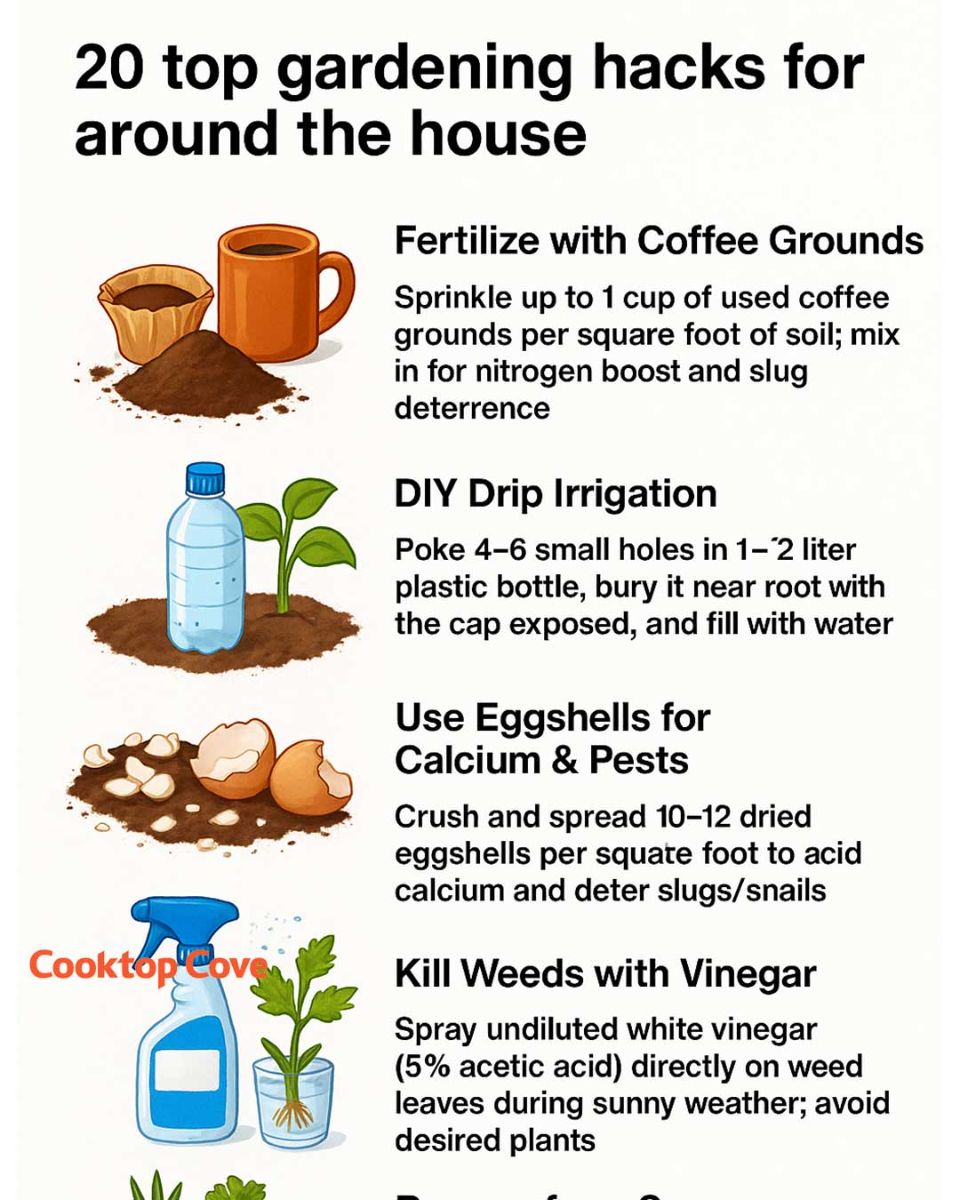20 top gardening hacks for around the house
Morgan Reed
Contributing Writer
Print this recipe
Gardening is not just a hobby; it’s a way to connect with nature and bring life to your surroundings. Whether you have a sprawling backyard or a small balcony, there are countless ways to make the most of your gardening space. With a little creativity and some household items, you can enhance your garden’s productivity and beauty without breaking the bank.
In this article, we will explore 20 top gardening hacks that you can easily implement around your house. These tips are designed to help you make the most of your gardening efforts, using simple and often overlooked materials that you probably already have at home. From natural fertilizers to ingenious planting techniques, these hacks will transform your gardening experience and help you cultivate a lush, thriving garden.
1. Use Coffee Grounds as Fertilizer
Coffee grounds are an excellent source of nitrogen, which is essential for plant growth. To use coffee grounds as a fertilizer, simply sprinkle them around the base of your plants. You can also mix them into the soil to improve its structure and drainage. For best results, use about one cup of coffee grounds per square foot of soil. Coffee grounds are particularly beneficial for acid-loving plants like roses, azaleas, and blueberries.
In addition to providing nutrients, coffee grounds can also help deter pests like slugs and snails. The coarse texture of the grounds is unpleasant for these creatures, making them less likely to feast on your plants. Just be sure not to overdo it, as too much coffee can make the soil too acidic for some plants.
2. Create a DIY Drip Irrigation System
A drip irrigation system is an efficient way to water your plants, ensuring they receive a steady supply of moisture without wasting water. To create a simple DIY drip irrigation system, you’ll need a plastic bottle and a few basic tools. Start by poking small holes in the sides of the bottle, then bury it in the soil near your plants, leaving the top exposed. Fill the bottle with water, and it will slowly seep out through the holes, providing a consistent supply of water to the roots.
This method is particularly useful for container gardens or raised beds, where water retention can be a challenge. You can also use multiple bottles for larger areas, adjusting the number and size of the holes to control the flow of water.
3. Repurpose Eggshells for Plant Health
Eggshells are rich in calcium, which is vital for plant health. To use eggshells in your garden, rinse them thoroughly and allow them to dry. Crush the shells into small pieces and sprinkle them around the base of your plants. This will help improve soil structure and provide a slow-release source of calcium.
Eggshells can also be used to deter pests like slugs and snails. The sharp edges of the crushed shells are uncomfortable for these pests to crawl over, making them an effective natural barrier. For best results, apply a generous layer of crushed eggshells around the perimeter of your garden beds.
4. Use Vinegar to Kill Weeds
Vinegar is a natural and effective weed killer that can help you maintain a tidy garden. To use vinegar for weed control, fill a spray bottle with white vinegar and apply it directly to the leaves of the weeds. The acetic acid in the vinegar will dry out the leaves, killing the weeds within a few days.
For best results, apply vinegar on a sunny day, as the heat will enhance its effectiveness. Be careful not to spray vinegar on your desirable plants, as it can harm them as well. For stubborn weeds, you may need to reapply the vinegar several times.
5. Grow Plants from Kitchen Scraps
Many kitchen scraps can be regrown into new plants, providing a sustainable way to expand your garden. For example, you can regrow green onions by placing the white roots in a glass of water. Within a few days, new shoots will begin to grow, and you can plant them in soil once they reach a few inches in height.
Other vegetables that can be regrown from scraps include lettuce, celery, and potatoes. Simply place the base of a lettuce or celery stalk in water and wait for new growth to appear. For potatoes, cut them into pieces with at least one ‘eye’ each, and plant them in soil. With a little patience, you’ll have a fresh supply of produce right from your kitchen.
6. Make a Natural Pest Repellent with Garlic
Garlic is a powerful natural pest repellent that can help protect your plants from insects. To make a garlic spray, blend two bulbs of garlic with a quart of water, then strain the mixture to remove any solids. Add a tablespoon of dish soap to help the solution adhere to plant leaves.
Spray the garlic solution on your plants, focusing on the undersides of leaves where pests often hide. This natural repellent is effective against a variety of insects, including aphids, beetles, and caterpillars. Reapply the spray every few weeks or after heavy rain to maintain its effectiveness.
7. Use Baking Soda to Sweeten Tomatoes
